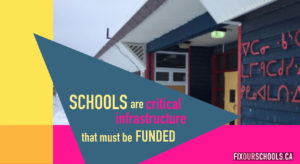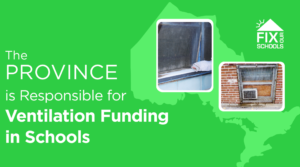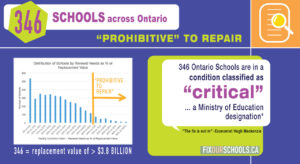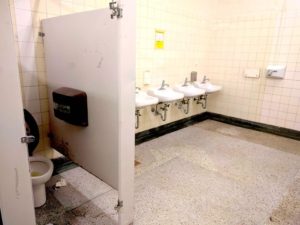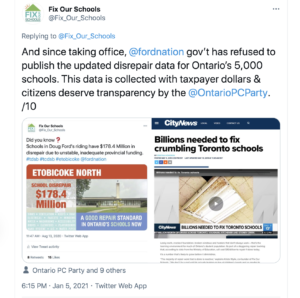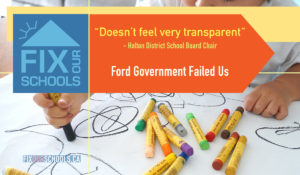Political parties in Ontario are already beginning to think about their platforms for the next provincial election. The Liberal party reached out to Fix Our Schools to provide input to the Education Platform they are building for the next provincial election, and have been seeking input from all citizens using a campaign called “Take the Mic” to solicit citizen’s opinions on a wide range of topics, including education. We hope that many of you in the Fix Our Schools network will provide input in the coming days. And, as a non-partisan campaign, Fix Our Schools hopes that you will take every opportunity in the coming days, weeks, and months to provide input to all political parties about what you believe is important to include in a strong education platform.
The COVID-19 pandemic has laid bare the criticality of schools that are safe, healthy, well-maintained buildings that provide environments conducive to learning. In 2020/2021 amidst a global pandemic, the gross and chronic underfunding of Ontario’s schools by successive provincial governments over 23 years came back to haunt us. We learned that we cannot underfund and neglect critical infrastructure for decades, and then expect that infrastructure to provide what is needed during an emergency situation. So, the time is now to learn from the hard lessons of this past year, and embed this learning into the education platforms being developed by our provincial parties.
With this in mind, we urge all provincial parties to prioritize investing in schools, and to include in their education platforms these recommendations, originally submitted to the government in our pre-budget submission in January 2021. Here is an overview of the detailed recommendations provided in our pre-budget submission:
1. A commonly understood and measurable standard of good repair must be developed and implemented for Ontario schools, that takes into consideration not only disrepair but also things such as air quality/ventilation, water quality, and temperature of classrooms.
These same standards must also be applied to all First Nations schools. Furthermore, these standards must be applied not only to permanent school buildings but also to portables, which often end up being on a school site for over a decade, instead of as a temporary measure, as originally intended. Integral to this new Standard of Good repair is a commitment to transparency into the state of all of Ontario’s publicly funded schools and portables, and First Nations schools.
2. A thoughtful, detailed review and revision of the education funding formula, which has allowed for $16.3-billion of disrepair to accumulate in Ontario’s publicly funded schools. Given the Ministry of Education is the sole funder of our publicly funded schools and education system, the Ministry holds responsibility for ensuring the funding formula provides adequate, stable funding for school infrastructure.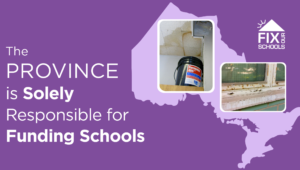
Therefore, we continue to call for an education funding formula that will include the following additional renewal and capital funding, and operational funding:
-
- Keep special School Condition Improvement (SCI) funding at $1 billion per year until the repair backlog is gone, in conjunction with the following funding steps:
- Increase annual School Renewal Allocation (SRA) funding from the current $357 million per year to $1.7 billion per year, and maintain that funding at 3% of the replacement value of Ontario’s schools to conform to the generally accepted level of renewal funding required to keep schools in a state of good repair.
- Create a new and separate capital stream of funding to replace the 346 school buildings across the province determined to be too expensive to repair as of the most recent provincial review cycle; estimated $3.9 billion one-time capital injection amortized over 40 years would result in a new budgetary expense of $100 million per year
- Increase the current operational maintenance budget by $165 million per year (an 8.7% increase from current levels, based on industry averages) and ensure that the formula used to determine this annual figure explicitly recognizes the underlying drivers of differences in operating costs for schools in the province including: labour costs in the community, heating costs in given climates, age & design of school buildings.
3. An updated provincial regulation that guides the collection and use of Education Development Charges must be developed and implemented, such that developers contribute to the local school infrastructure from which they ultimately profit. Of note is that back in 2018, Canada’s largest school board, the Toronto District School Board (TDSB) challenged the Ontario government on the equity of its EDC regulations. This hearing is now set to take place on March 25, 2021 at the Ontario Superior Court of Justice. In the hearing, the TDSB seeks to have the court declare certain provisions of the Education Act regulations invalid and permit TDSB to charge Educational Development Charges. Fix Our Schools has been pushing for these changes since our inception in 2014, and recently co-authored a paper called The Missing Money Our Schools Need Now, so we will be watching this court decision closely.
4. An approach to school closures must be developed and implements, that is not focused on utilization rates but, instead, determines the importance of a school to its surrounding community and considers the implications for student access to programs and commute times. If a school is open, then its capital costs and operational maintenance costs must be fully funded by the provincial government, regardless of the utilization of that school.
5. Provide additional funding for school boards to reasonably meet the 2025 deadline for compliance with Accessibility for Ontarians with Disabilities (AODA) Act. The goal for Ontario is to be fully accessible by 2025, including publicly funded schools. Clearly, when the current provincial levels of funding don’t even allow for school boards to proactively address disrepair, without specific funding for AODA repair and renewal items in schools, school boards cannot reasonably meet the 2025 deadline for full accessibility in schools.
It is also a decision to discriminate. https://t.co/lCWT47I4Yb
— David C. Onley, OOnt (@HonDavidOnley) March 6, 2019
So to recap, Fix Our Schools urges every provincial party to prioritize safe, healthy, well-maintained schools that provide environments conducive to learning and working. We believe the recommendations we have made ought to be an integral part of each party’s education platform for the next provincial election. We know that our recommended platform for schools requires a lot of new money to be invested in publicly funded schools. We also know that:
- Schools are a critical element of our public infrastructure, made even more evident during the COVID pandemic
- 2 million Ontario children spend their days in school buildings and need safe, healthy, well-maintained places to learn.
- Teachers, education workers, adult learners, and pre-schoolers who attend childcare facilities in local public schools also need safe, healthy, well-maintained environments in which to work and learn.
- Repairs in Ontario’s schools are only going to get more expensive if we do not fully address the $16.3 billion repair backlog as soon as possible.
Therefore, if we collectively agree that we value our children and we value their education then we will start to do what it takes to truly fix Ontario’s schools and fix the broken provincial funding approach to education that has allowed $16.3 billion of disrepair to accumulate in Ontario’s schools.

